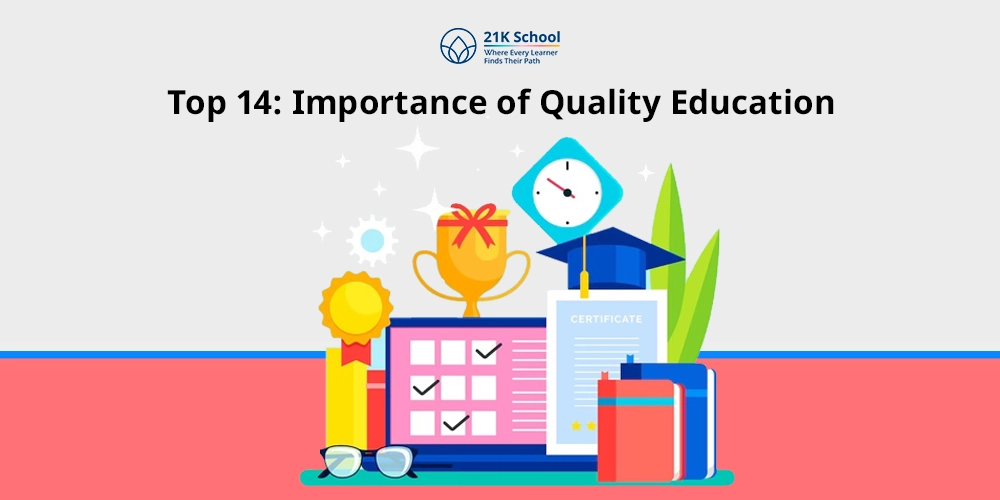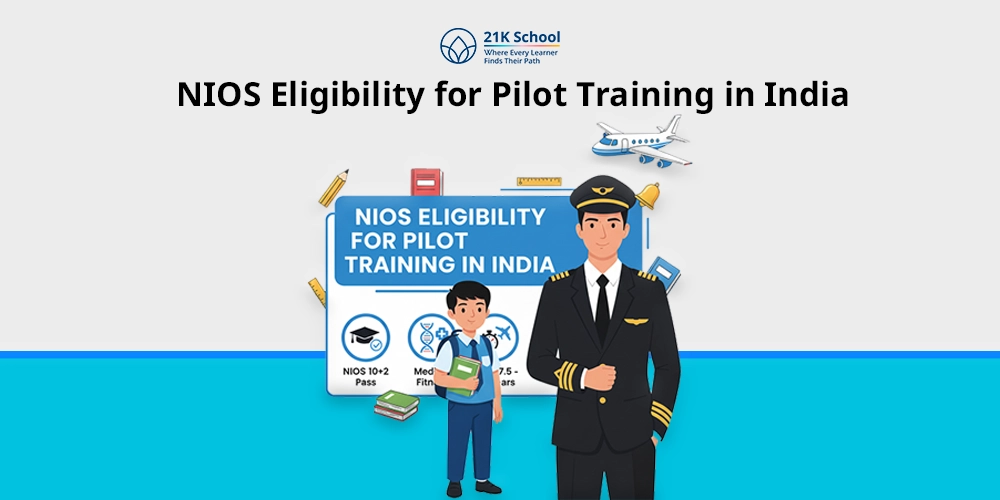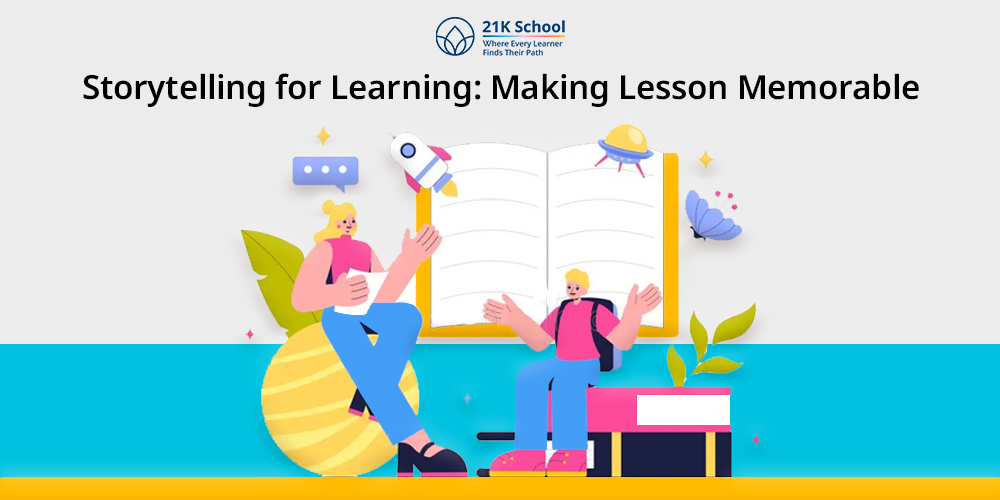
Do you know what is the powerful and engaging way of learners? If not you can use Storytelling for learning.
Yes you heard it right, Storytelling for learning is an amazing learning style designed to engage learners especially in boring subjects.
It aims to make any lesson or chapter interesting, memorable and relatable. An ideal story includes emotions, foster critical thinking and enhance cultural awareness.
It’s time to make complex learning easy and effective which promotes deeper understanding. Let’s understand why Storytelling for learning is significant and how to implement it in a classroom setting.
Contents
- What is Storytelling for learning?
- How Storytelling Works: The Science Behind It
- Importance of Storytelling to Child Development
- Storytelling and Leadership Development
- Types of Storytelling
- Tips to Use Storytelling Effectively in Learning
- How to Use Storytelling in the Classroom?
- Benefits of Storytelling in Education
- Challenges and Solutions of Storytelling in Classroom
- Conclusion
What is Storytelling for learning?
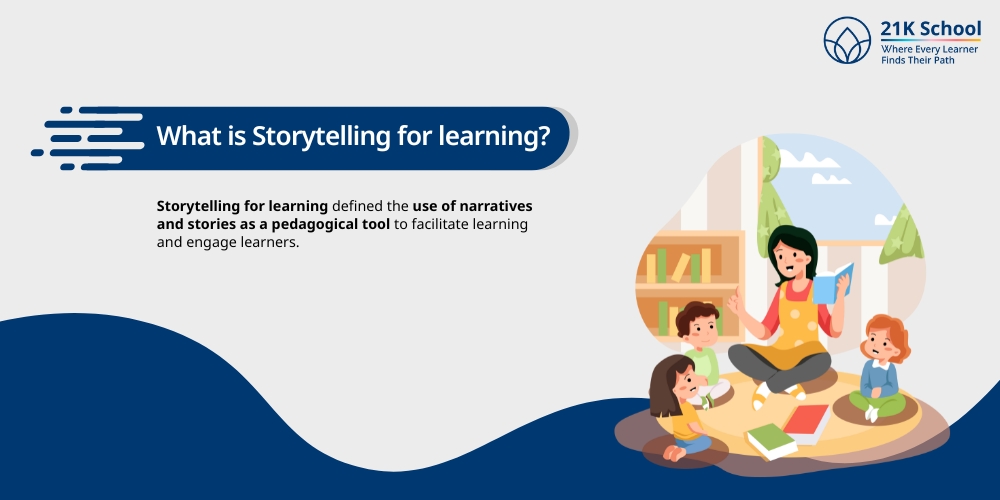
Storytelling for learning defined the use of narratives and stories as a pedagogical tool to facilitate learning and engage learners.
This includes presenting information or lessons in such a way that engages students and is memorable for the long run.
This kind of learning experience is more relatable, memorable, and enjoyable for all kinds of learners.
How Storytelling Works: The Science Behind It
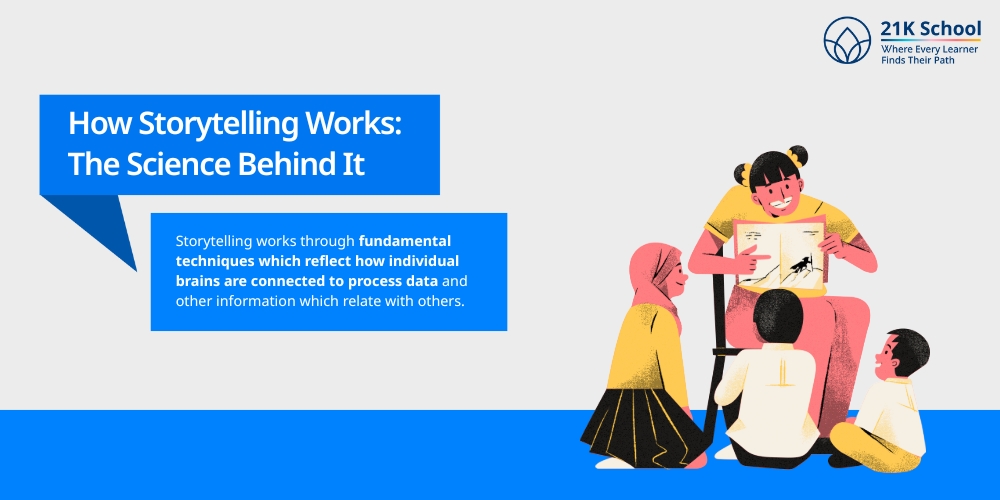
Storytelling works through fundamental techniques which reflect how individual brains are connected to process data and other information which relate with others.
It helps in activating multiple brain parts, especially those connected with individuals’ emotional learning, memory games , and even sensory experiences.
This makes stories more impactful and attractive than simply presenting facts.
From a cognitive science perspective, individuals’ brains are wired for stories. When data is shared in a narrative format, it understands better and recalls it more without any stress.
The structure of a story includes the beginning, middle part and the end. It aligns with the way individuals memory systems process information.
Also, storytelling is ideal for the release of oxytocin. It is a hormone connected to empathy and bonding of humans.
This makes learners more connected with the ongoing lessons and its features.
Importance of Storytelling to Child Development
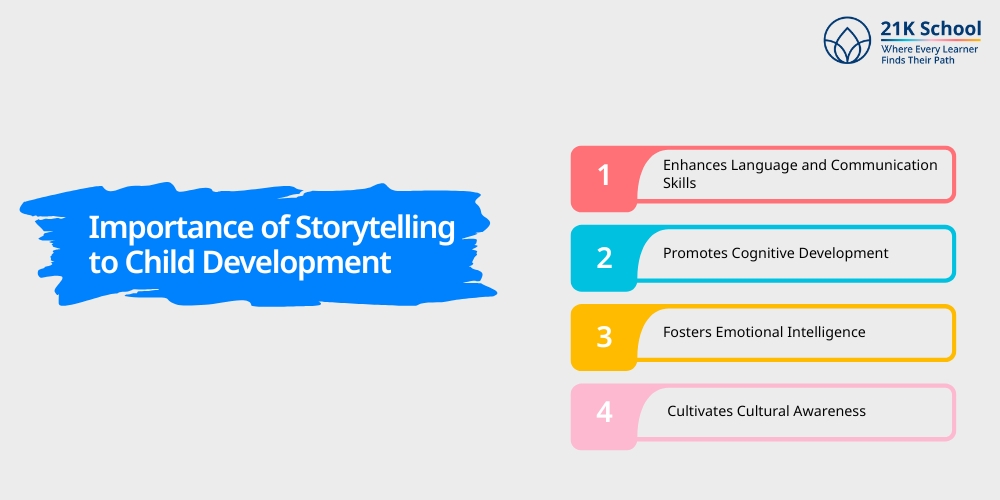
Storytelling for learning ensures child development. It enhances language skills , cognitive development, emotional intelligence and cultural understanding.
Not only these it also fosters imagination, creativity in child development , and a love for reading, while also promoting social skills and empathy.
1. Enhances Language and Communication Skills
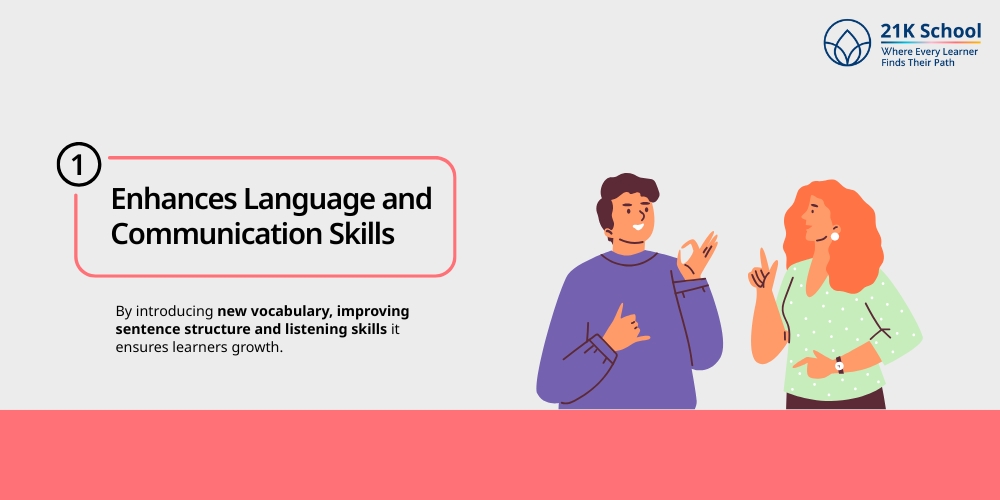
Enhancing language and communication skills of learners is what storytelling does. By introducing new vocabulary, improving sentence structure and listening skills it ensures learners growth.
Now, kids can also develop narrative skills, imagination, emotional intelligence and many more skills. All these are crucial for effective communication.
2. Promotes Cognitive Development
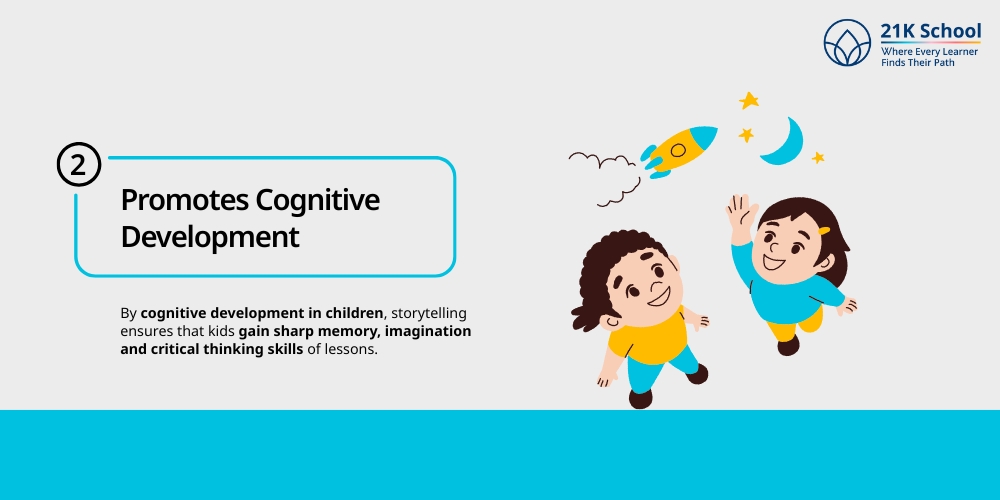
By cognitive development in children , storytelling ensures that kids gain sharp memory, imagination and critical thinking skills of lessons.
The impact of storytelling also leads to improved language skills, focus and concentration and building emotional and social skills.
3. Fosters Emotional Intelligence
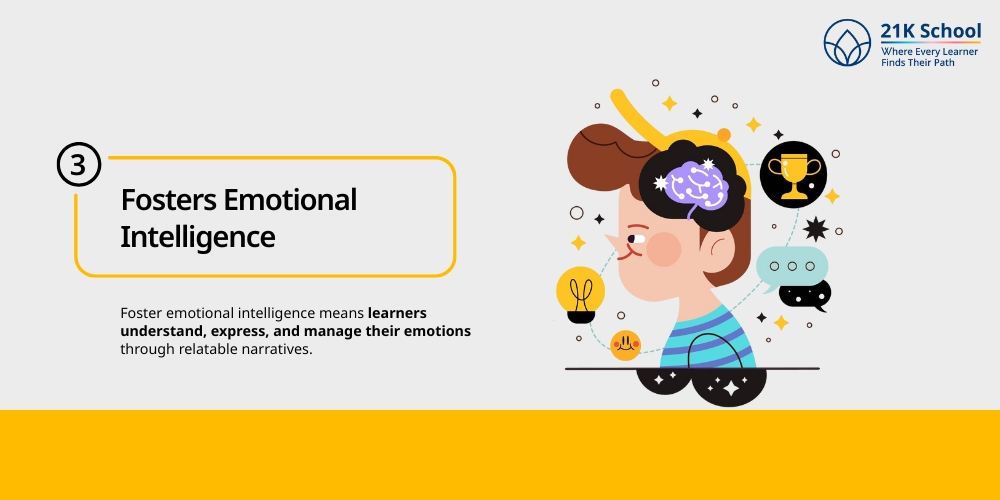
Foster emotional intelligence means learners understand, express, and manage their emotions through relatable narratives.
By connecting with characters and their experiences, develop empathy in children , recognize their own feelings and learn coping mechanisms for challenging emotions.
The way facilitators tell stories leads to language development, cognitive skills, and social skills.
4. Cultivates Cultural Awareness
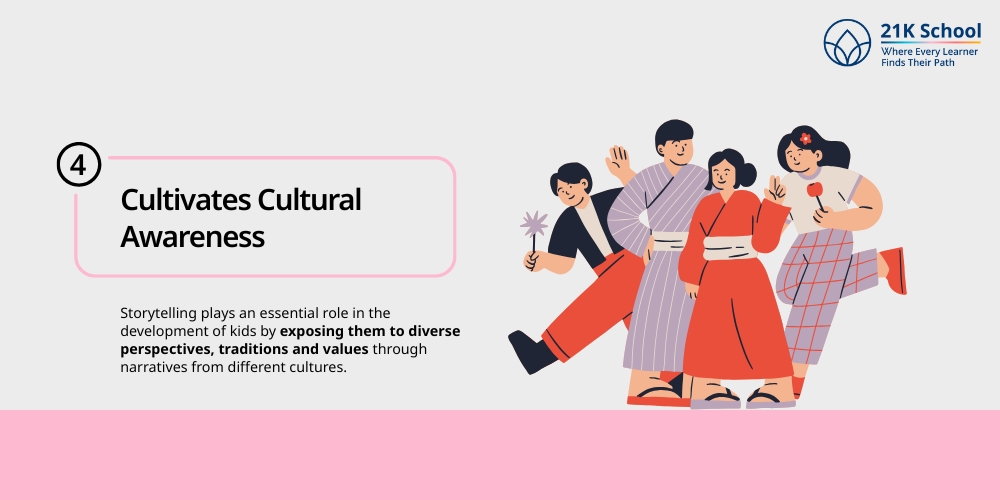
Cultivating cultural awareness refers to understanding the values.
However, storytelling plays an essential role in the development of kids by exposing them to diverse perspectives, traditions and values through narratives from different cultures.
This not only improves empathy and critical thinking but also inclusive learning , preparing children to be global citizens.
Storytelling and Leadership Development
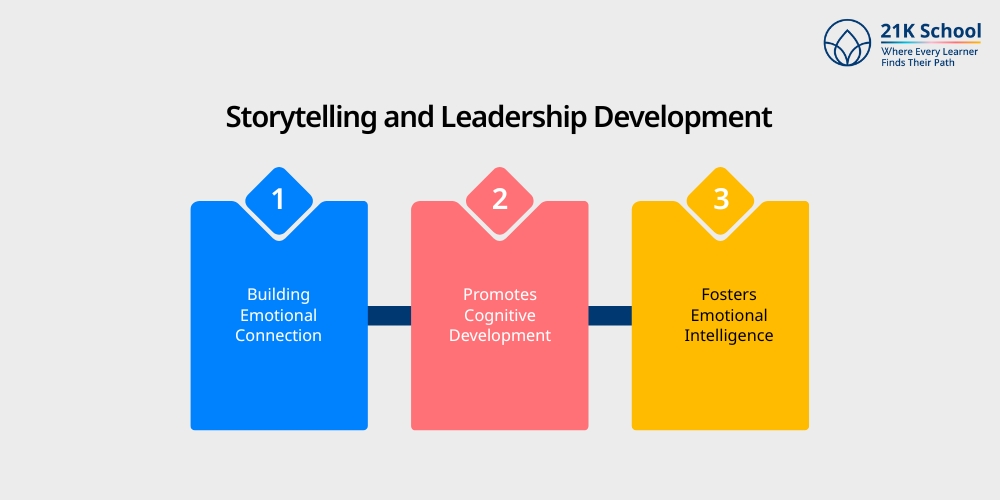
Storytelling is an effective approach for leadership development. It enables leaders to connect with their members on an emotional level, inspire action and improves a sense of shared purpose.
By storytelling leaders can make complex information more relatable and memorable which ultimately drives greater engagement and commitment from their team members.
Let’s understand why storytelling is important in leadership in students :
1. Building Emotional Connection
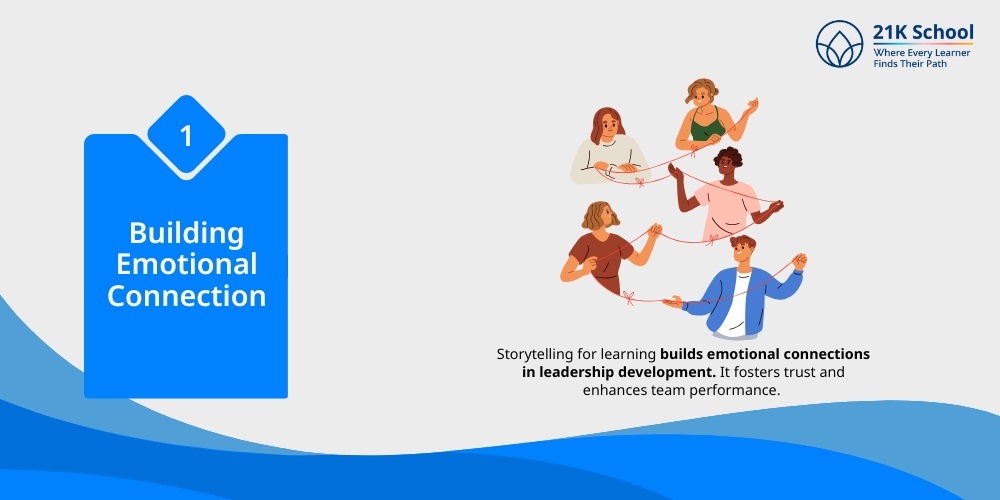
Storytelling for learning builds emotional connections in leadership development. It fosters trust and enhances team performance.
By sharing personal experiences with peers and compelling narratives, leaders can create relatable connections with their teams.
This makes connections more impactful than ever before.
This method improves communication and cultivates emotional intelligence, empathy and a sense of shared purpose. It leads to stronger relationships and improved collaboration skills.
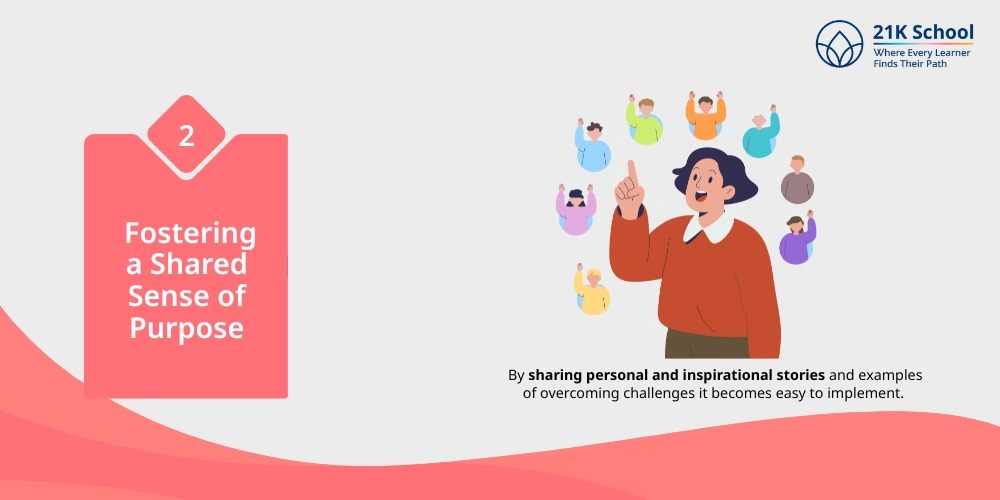
Storytelling fosters a shared sense of purpose with everyone.
By sharing personal and inspirational stories and examples of overcoming challenges it becomes easy to implement.
Leaders can create deeper emotional bonds, inspire action, and build a strong sense of community.
3. Developing Leadership Skills
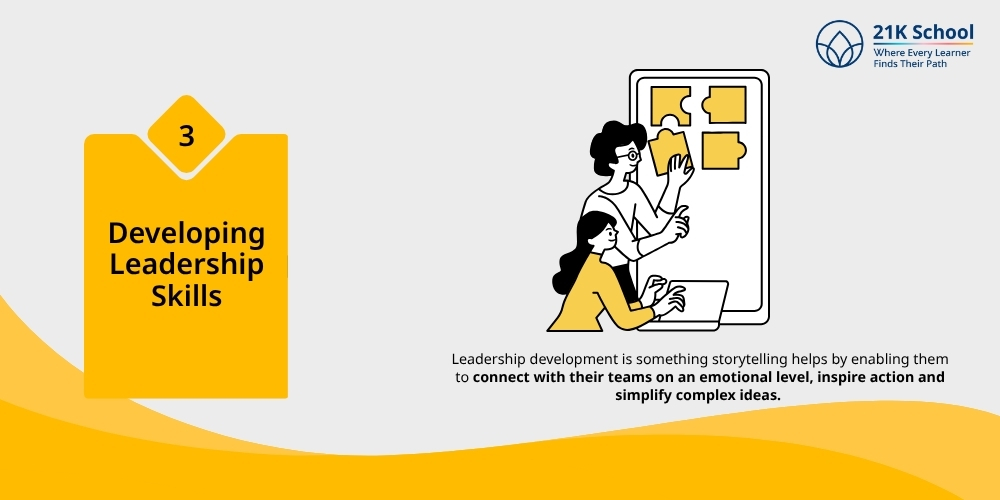
Leadership development is something storytelling helps by enabling them to connect with their teams on an emotional level, inspire action and simplify complex ideas.
One can also explore different kinds of leadership activities for students.
By making narratives, leaders can build trust, foster engagement and convey their vision and values more effectively.
Types of Storytelling
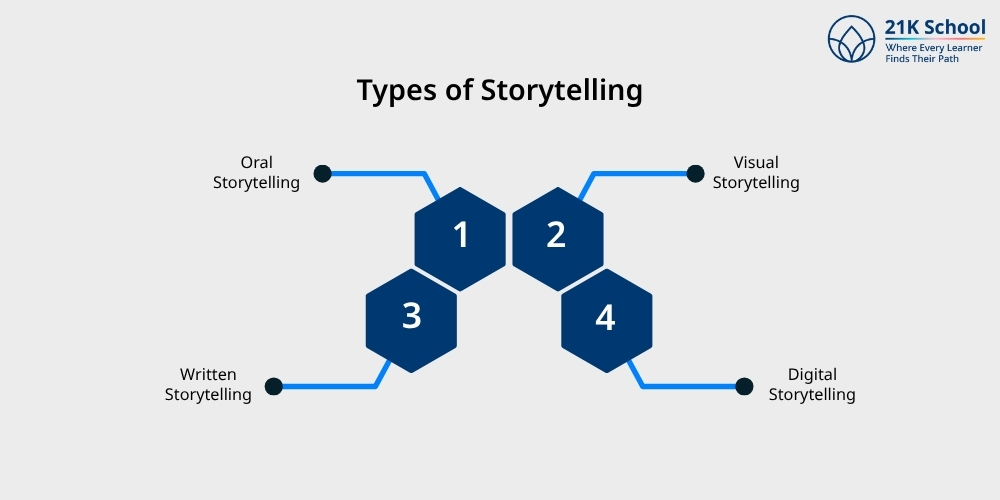
Storytelling is categorised into oral, written, visual, and digital forms. These forms are used in different methods to convey narratives, including spoken word, written text, images, and interactive media.
Here’s a detailed understanding of different types of storytelling:
1. Oral Storytelling
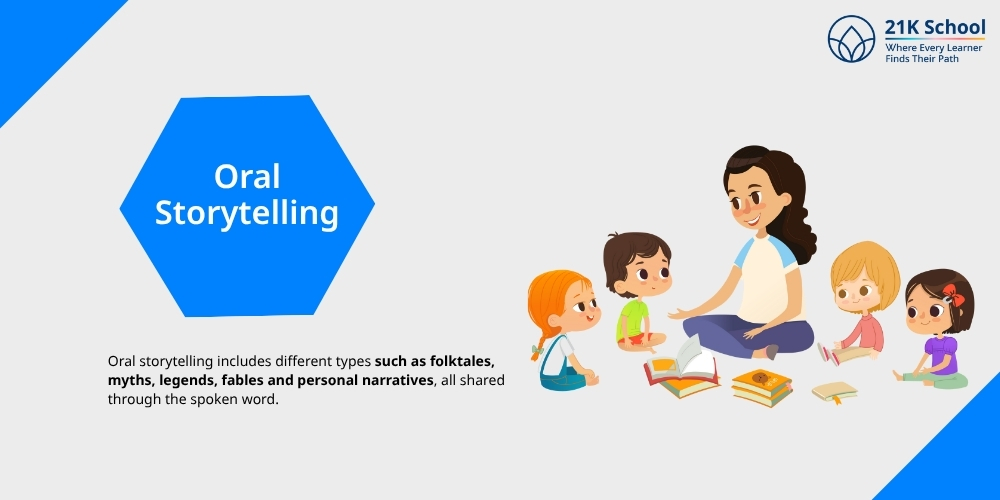
Oral storytelling includes different types such as folktales, myths, legends, fables and personal narratives, all shared through the spoken word.
It’s a dynamic art form where the storyteller’s voice, gestures, and interaction with others shape the narrative experience.
Oral traditions are essential in preserving cultural heritage, transmitting knowledge, and fostering a sense of community.
2. Written Storytelling
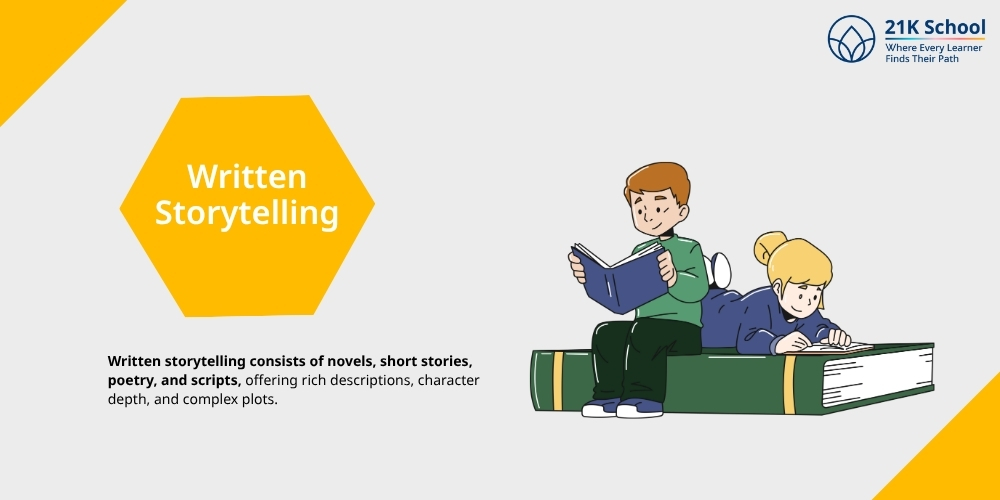
Written storytelling consists of novels, short stories, poetry, and scripts, offering rich descriptions, character depth, and complex plots.
It promotes student engagement at their own pace. Evolving from ancient epics to modern literature, it has adapted across diverse formats and platforms.
3. Visual Storytelling
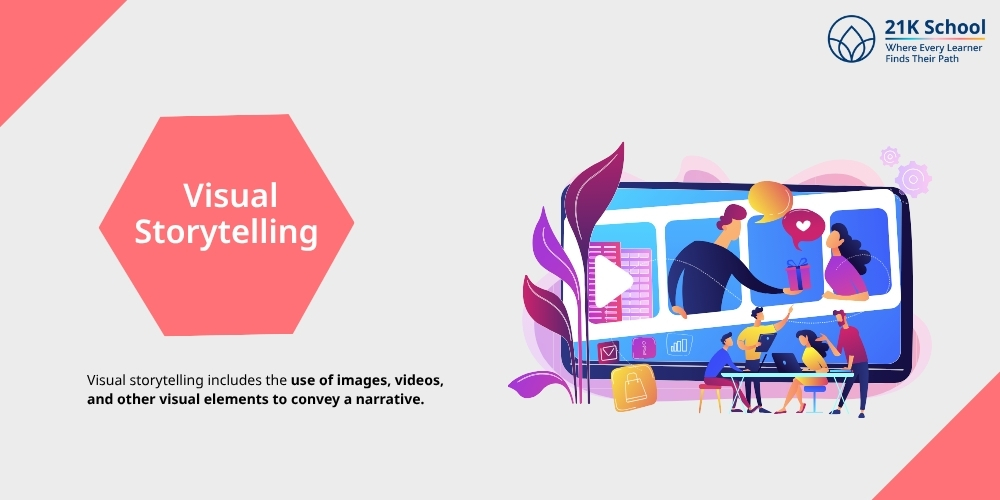
Visual storytelling includes the use of images, videos, and other visual elements to convey a narrative.
It’s an effective way to engage audiences, explain complex concepts and evoke emotions. This often surpasses the impact of text alone.
There are various kinds of visual storytelling such as photographs, illustrations, animations, infographics, data visualizations, comics, and even interactive learning experiences like VR and AR .
4. Digital Storytelling
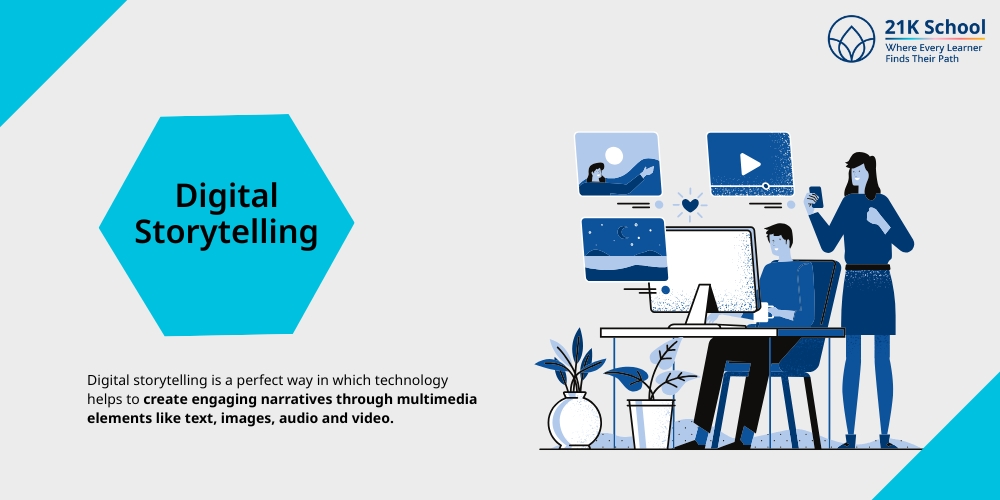
Digital storytelling is a perfect way in which technology helps to create engaging narratives through multimedia elements like text, images, audio and video.
It includes the combination of various formats such as personal narratives, historical documentaries, informative pieces, and interactive experiences.
Tips to Use Storytelling Effectively in Learning
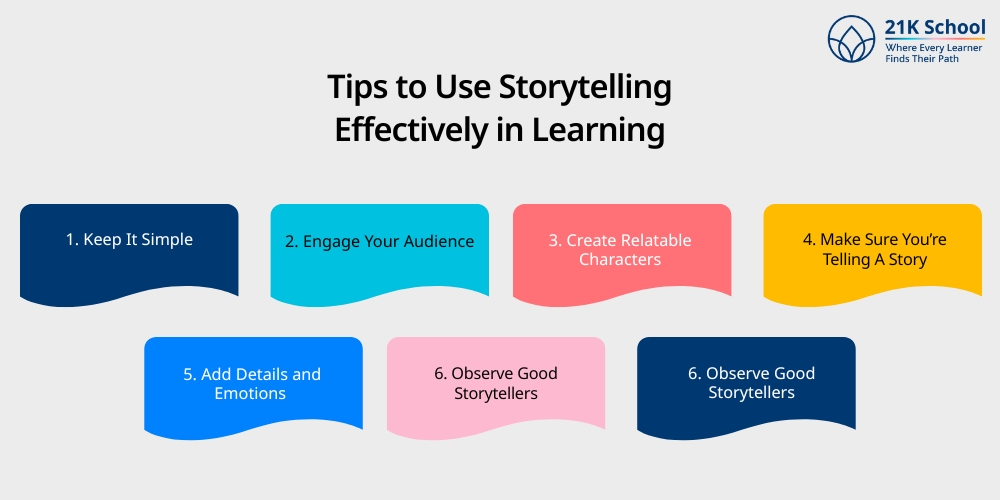
For effective use of Storytelling for learning, one needs to focus on crafting compelling narratives that are relatable, emotionally engaging, and aligned with learning objectives.
Facilitators can use visuals, multimedia, and encourage active participation to enhance the positive learning environment . Here’s come common tips:
1. Keep It Simple
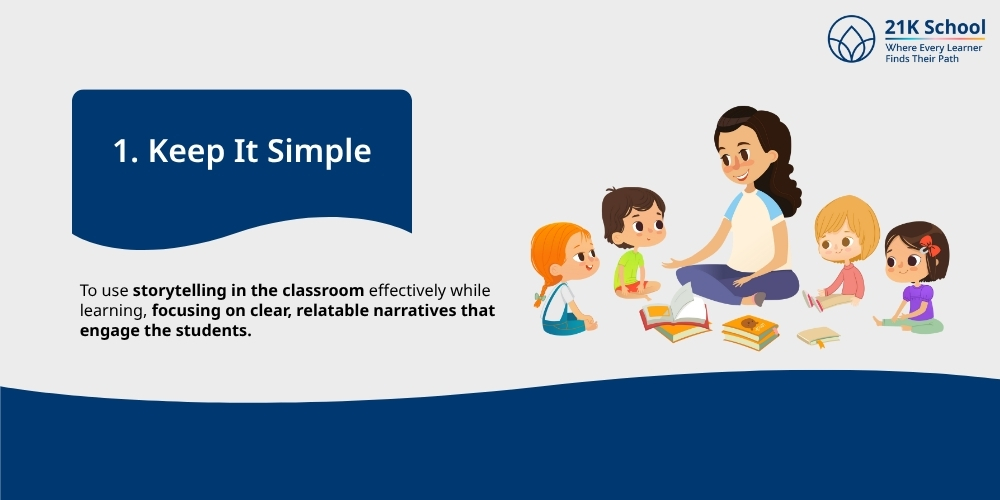
To use storytelling in the classroom effectively while learning, focusing on clear, relatable narratives that engage the students.
Keep the stories simple, concise, use visuals and connect emotionally to the content. This ensures stories are relevant to learning objectives and encourages learners participation.
2. Engage Your Audience
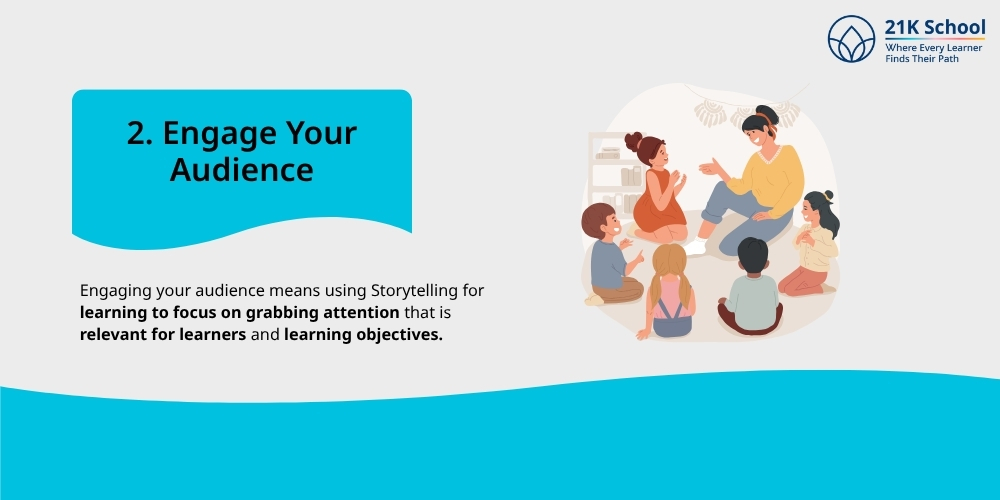
Engaging your audience means using Storytelling for learning to focus on grabbing attention that is relevant for learners and learning objectives.
Facilitators can use vivid language, relatable characters and a clear structure to draw learners into the story. This increases curiosity and discussion to make the learning experience interactive and memorable.
3. Create Relatable Characters
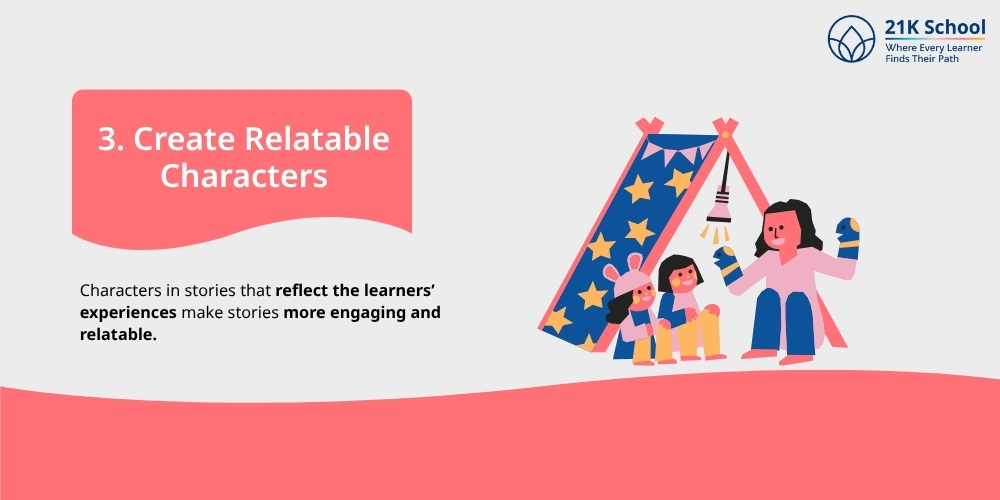
Characters in stories that reflect the learners’ experiences make stories more engaging and relatable.
Whether it’s a curious child, a struggling inventor, or a misunderstood animal, each figure’s characteristics foster empathy and connection.
4. Make Sure You’re Telling A Story
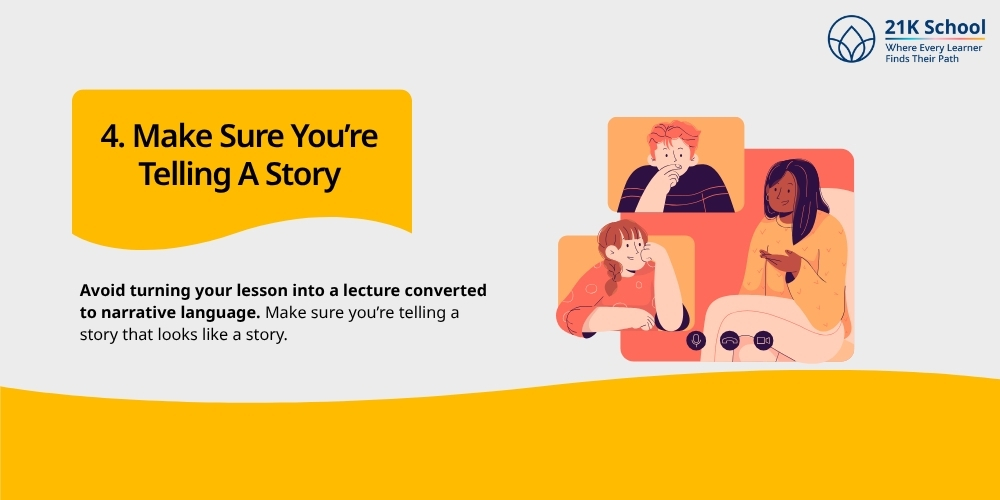
Avoid turning your lesson into a lecture converted to narrative language. Make sure you’re telling a story that looks like a story.
A true story has everything, conflict, resolution, and emotional arc. Ensure your narrative has these elements.
5. Add Details and Emotions
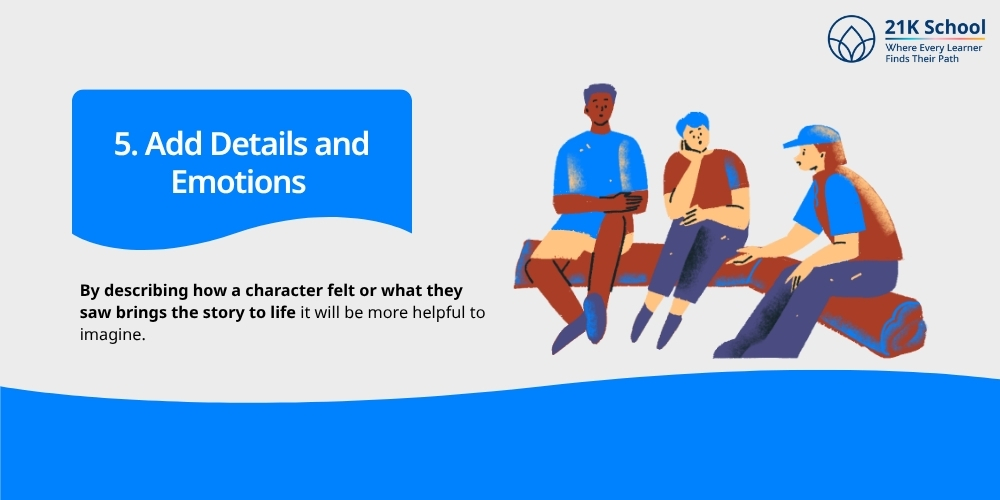
Sensory details and emotional angles make stories more effective. By describing how a character felt or what they saw brings the story to life it will be more helpful to imagine.
6. Observe Good Storytellers
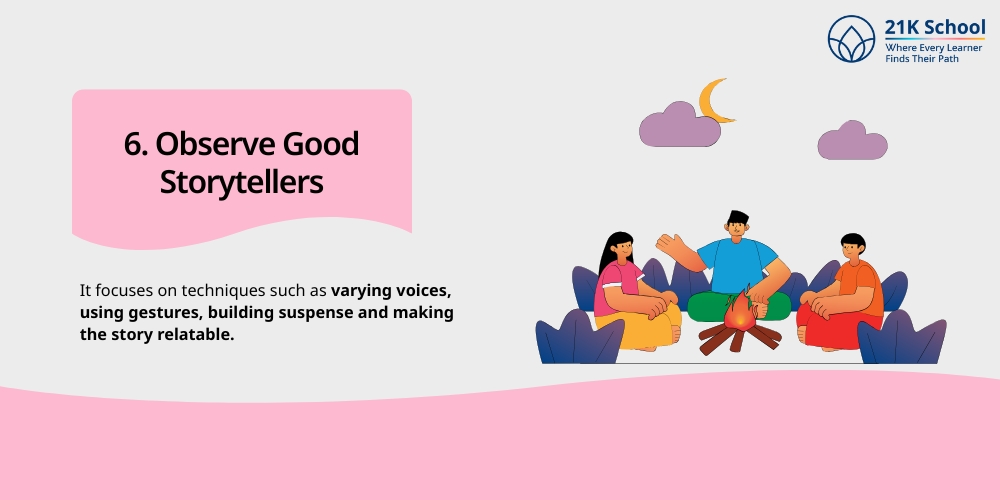
An effective Storytelling for learning which observes how good storytellers engage the learners. It focuses on techniques such as varying voices, using gestures, building suspense and making the story relatable.
One must include personal experiences, creating clear narrative structures and highlighting problems and its solutions to enhance the learning experience.
7. Practice Telling Stories
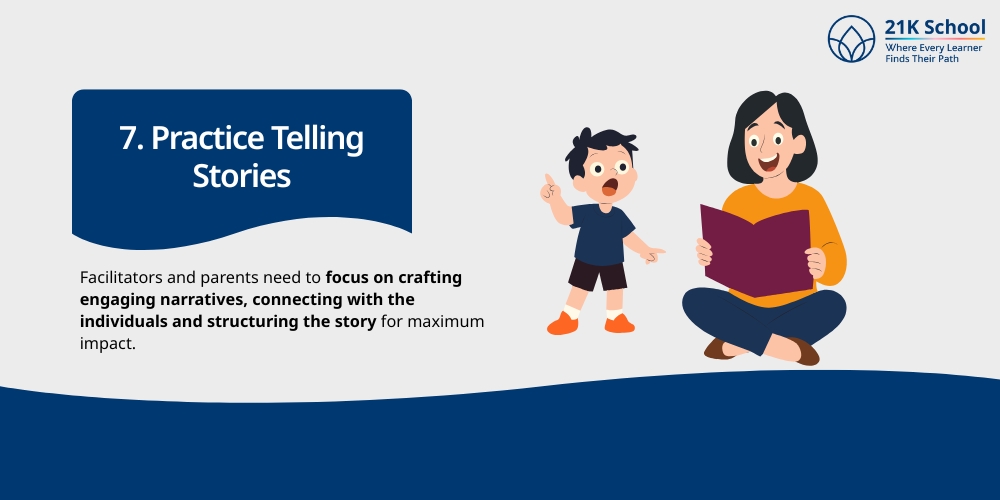
To use storytelling effectively in learning, facilitators and parents need to focus on crafting engaging narratives, connecting with the individuals and structuring the story for maximum impact.
This includes selecting a relatable story, using clear language and imagery and incorporating elements like conflict and resolution.
How to Use Storytelling in the Classroom?
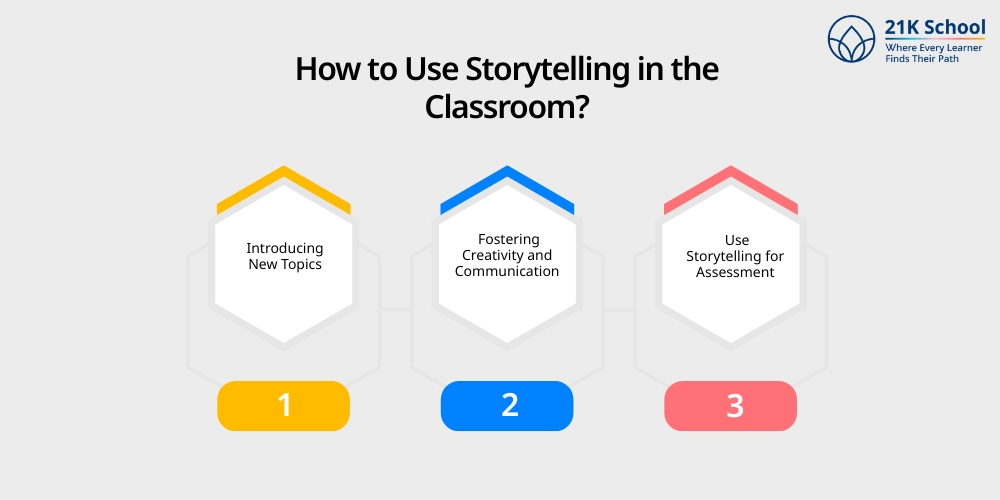
There are many ways to use storytelling in the classroom to enhance engagement, understanding, and retention of information.
Facilitators can introduce storytelling with new chapters or topics with a narrative, using personal story or thoughts to assign digital storytelling projects.
Here’s a more detailed look at how to use storytelling in the classroom:
1. Introducing New Topics
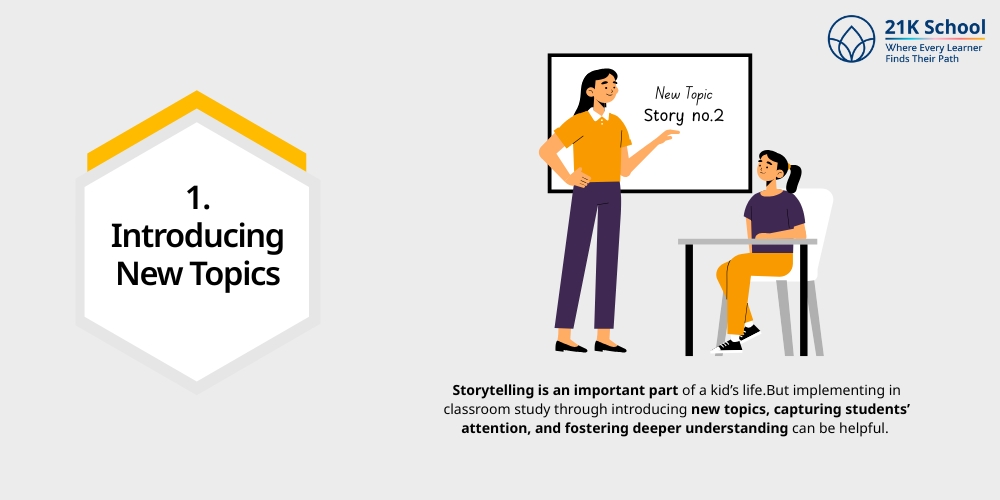
Storytelling is an important part of a kid’s life. But implementing in classroom study through introducing new topics, capturing students’ attention, and fostering deeper understanding can be helpful.
By using narratives, educators can make learning more engaging, relatable, and memorable.
2. Fostering Creativity and Communication
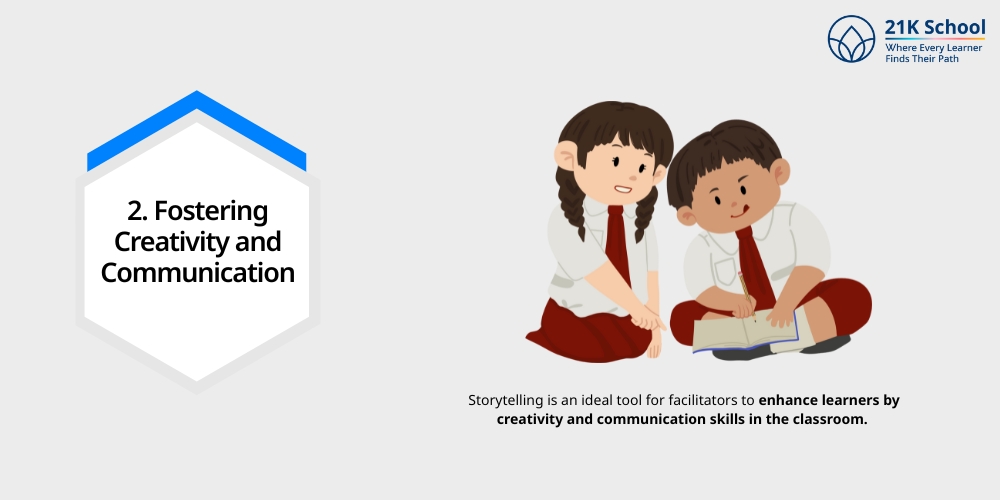
Storytelling is an ideal tool for facilitators to enhance learners by creativity and communication skills in the classroom.
By including storytelling methods, facilitators can foster engagement, critical thinking and a deeper understanding of various subjects.
3. Use Storytelling for Assessment
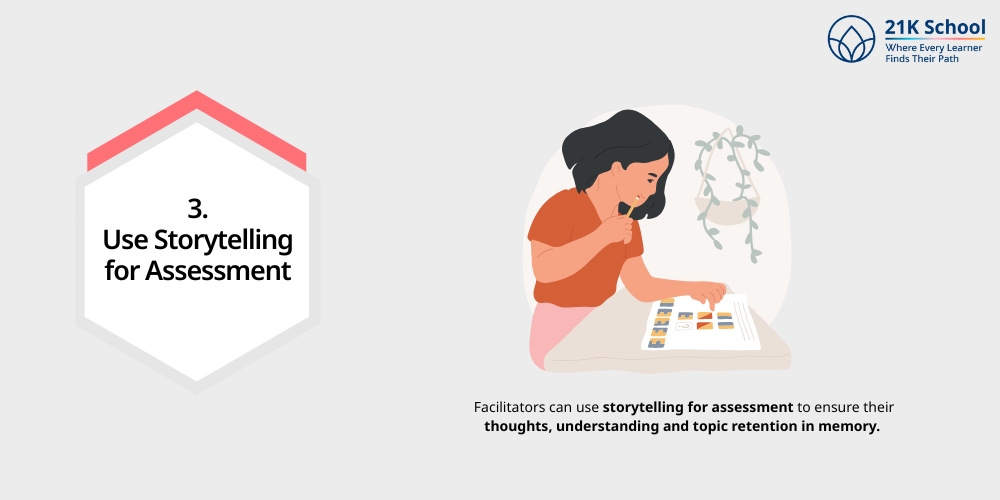
Facilitators can use storytelling for assessment to ensure their thoughts, understanding and topic retention in memory.
For example one can ask learners to demonstrate their understanding through storytelling formats instead of traditional tests.
Benefits of Storytelling in Education
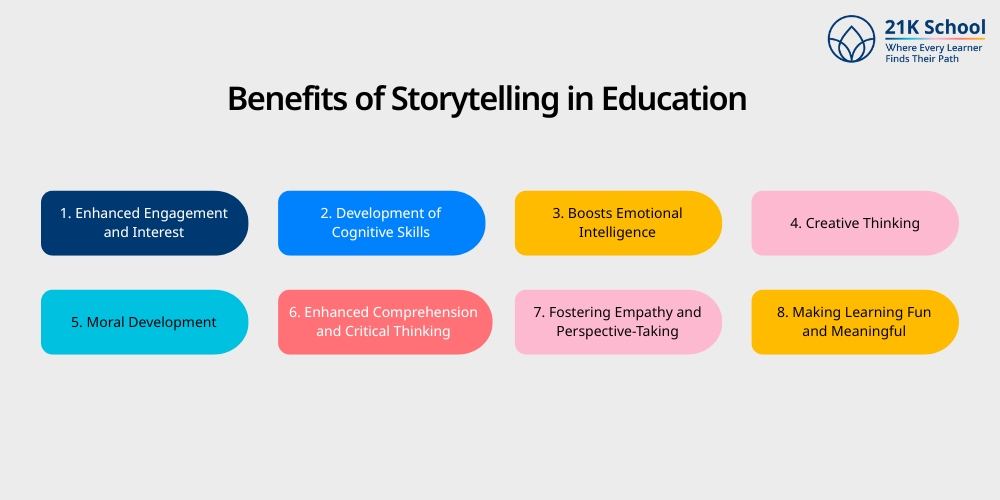
Storytelling provides several benefits in education. by fostering creativity, enhancing language skills, promoting emotional intelligence and improving memory retention.
It can also create a more engaging, curious and memorable learning experience. Let’s get a more detailed look at the benefits:
1. Enhanced Engagement and Interest
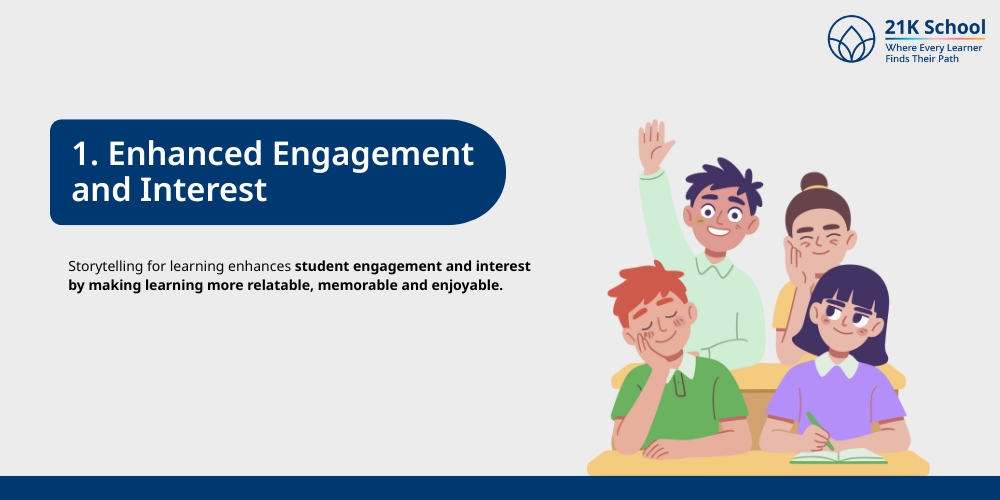
Storytelling for learning enhances student engagement and interest by making learning more relatable, memorable and enjoyable.
It improves a deeper understanding of concepts, encourages active participation and cultivates valuable skills like creativity, critical thinking, and emotional intelligence.
2. Development of Cognitive Skills
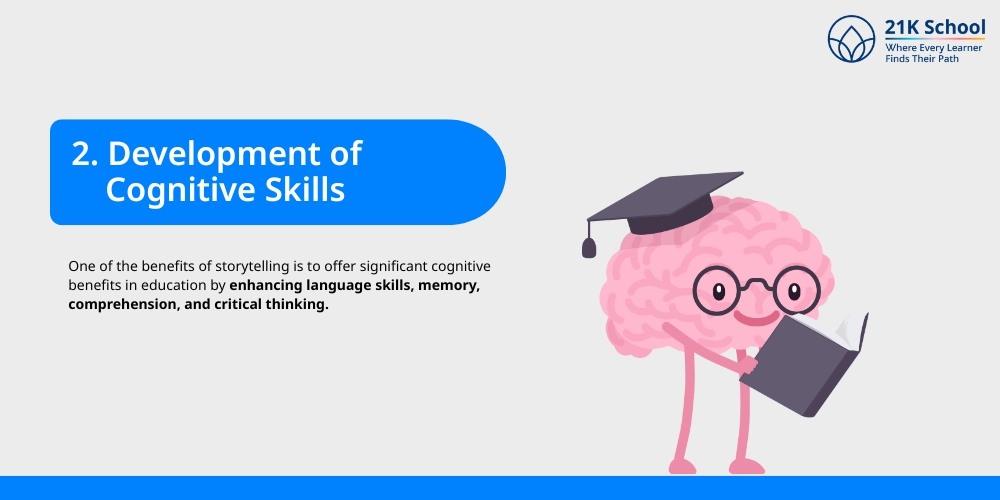
One of the benefits of storytelling is to offer significant cognitive benefits in education by enhancing language skills, memory, comprehension, and critical thinking.
Through engaging narratives, children develop crucial cognitive abilities. For example, memory retention, sequencing, and problem-solving .
However, it also fosters creativity, imagination, and cultural awareness.
3. Boosts Emotional Intelligence
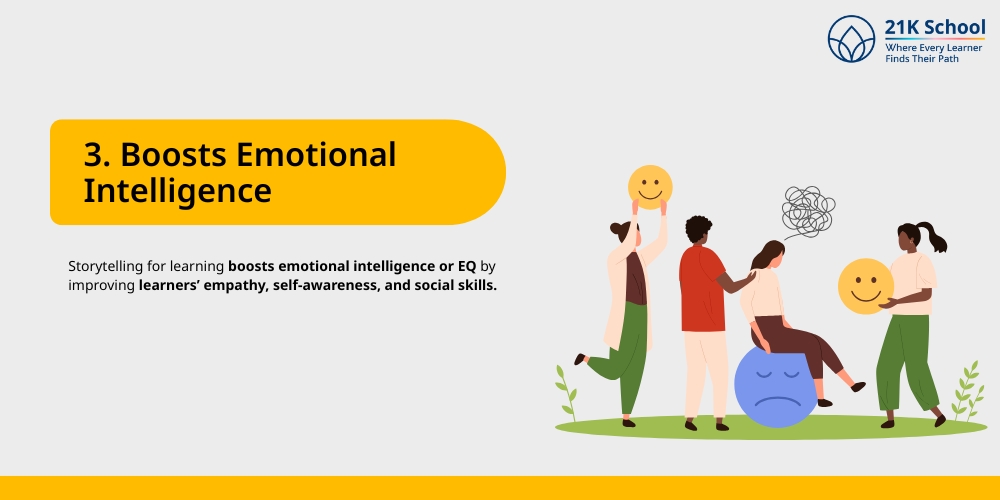
Storytelling for learning boosts emotional intelligence or EQ by improving learners’ empathy, self-awareness, and social skills.
Also, learn popular self-awareness activities for students’ growth.
Now, learners explore complex emotions, understand diverse perspectives and learn to navigate social situations.
This will later enhance their ability to manage their own feelings and interact effectively with others.
4. Creative Thinking
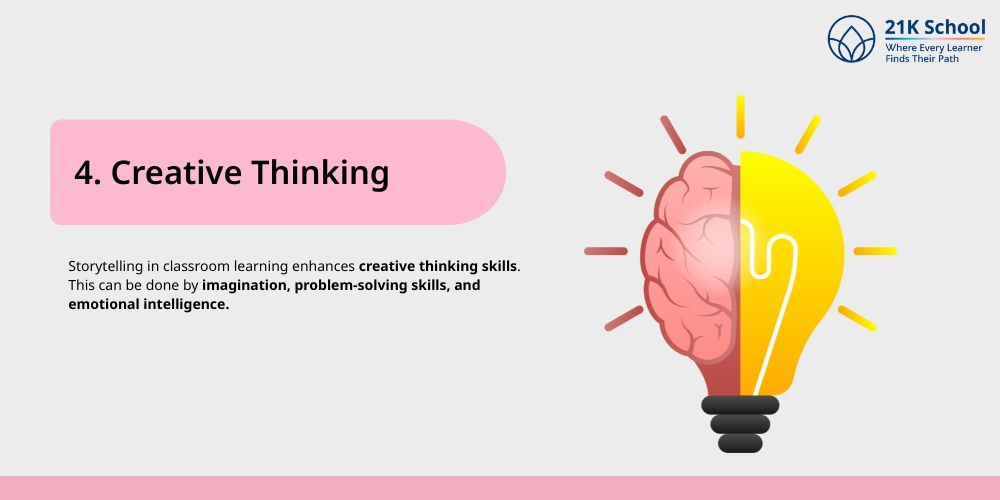
Storytelling in classroom learning enhances creative thinking skills . This can be done by imagination, problem-solving skills , and emotional intelligence.
It enhances learners’ education to visualize scenarios, interpret narratives, and develop unique perspectives, leading to improved cognitive and communication abilities.
5. Moral Development
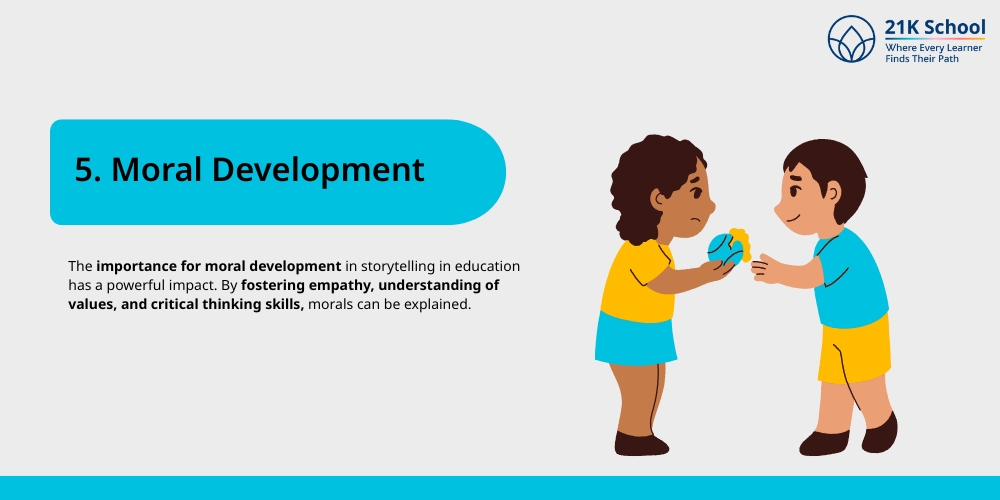
The importance for moral development in storytelling in education has a powerful impact. By fostering empathy, understanding of values, and critical thinking skills, morals can be explained.
With proper narratives, children explore complex emotions, learn to recognize right and wrong and develop a stronger sense of self and others.
6. Enhanced Comprehension and Critical Thinking
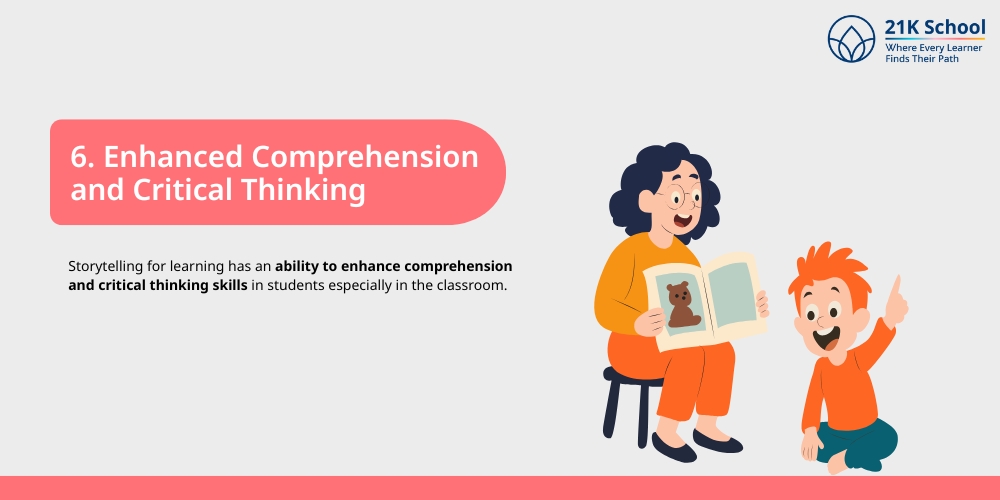
Storytelling for learning has an ability to enhance comprehension and critical thinking skills in students especially in the classroom.
By embedding information within narratives, it improves memory retention and fosters deeper understanding.
For example, analyzing stories after completion encourages learners to question, interpret, and evaluate information, leading to the development of critical thinking abilities.
7. Fostering Empathy and Perspective-Taking
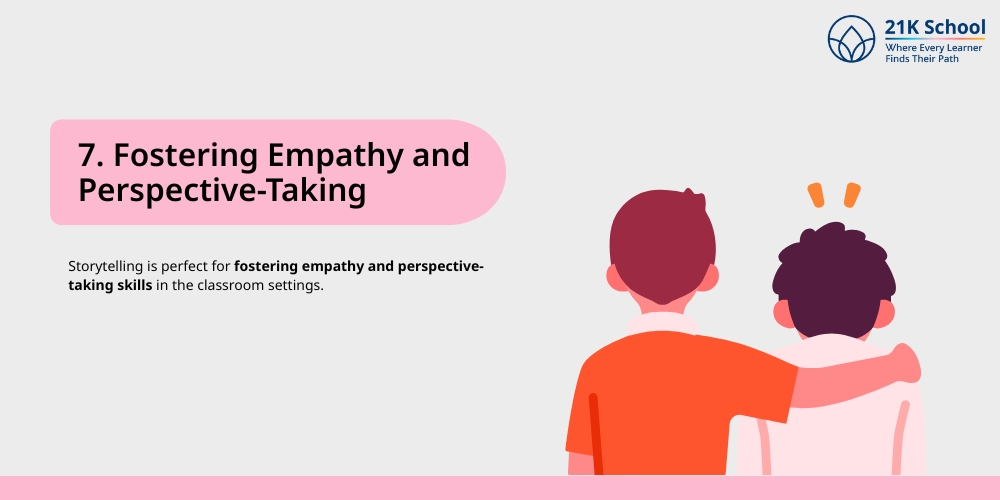
Storytelling is perfect for fostering empathy and perspective-taking skills in the classroom settings.
This can be done by educators who can foster emotional literacy, encourage understanding of dynamic learning and develop their critical thinking skills in students .
This ultimately leads to more engaged and socially aware learners as parents want.
8. Making Learning Fun and Meaningful
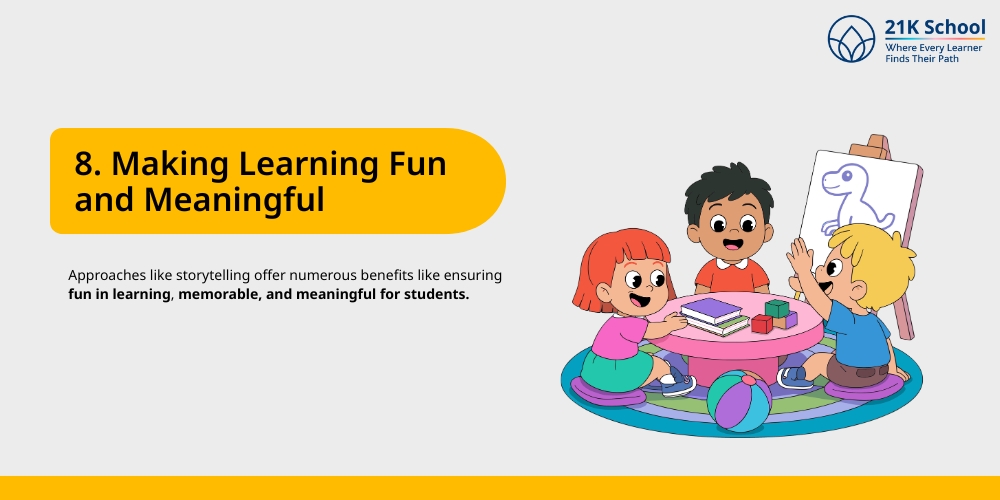
Education is not limited to strict or serious learning. Approaches like storytelling offer numerous benefits like ensuring fun in learning , memorable, and meaningful for students.
It enhances language skills, fosters creativity, improves memory, and develops emotional intelligence without any pressure or stress.
By connecting with simple success stories , learners develop a deeper understanding of the material and a greater appreciation for learning.
There are many more benefits of Storytelling for learning that guides facilitators and parents to improve students’ learning especially in this competitive world. Remember to incorporate an effective story.
Challenges and Solutions of Storytelling in Classroom
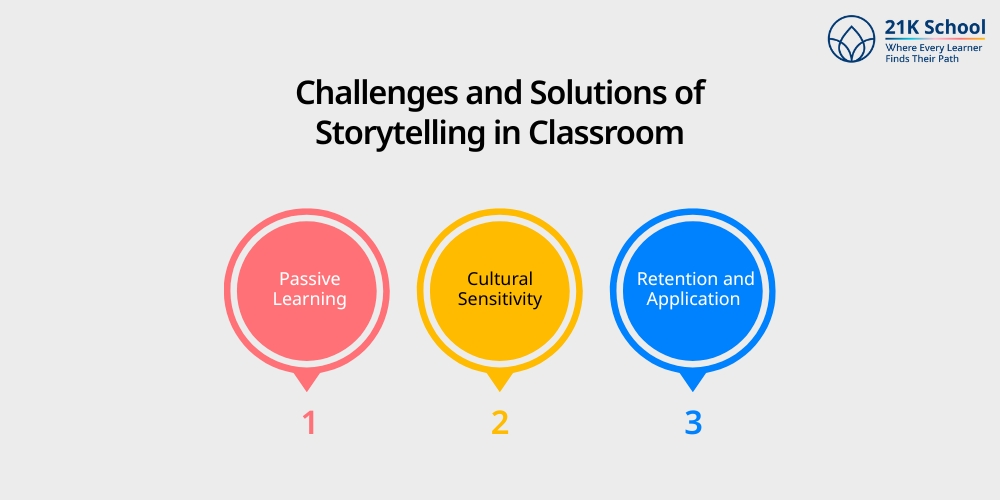
Storytelling in the classroom has various benefits for student engagement and learning. But, it also comes with few challenges.
Various challenges include passive learning, limited hands-on experience and the potential for predictable or misaligned content.
However, understanding these challenges requires thoughtful planning and implementation of strategies to ensure effective and engaging storytelling in the classroom.
Common challenges and solutions of storytelling in classroom:
1. Passive Learning
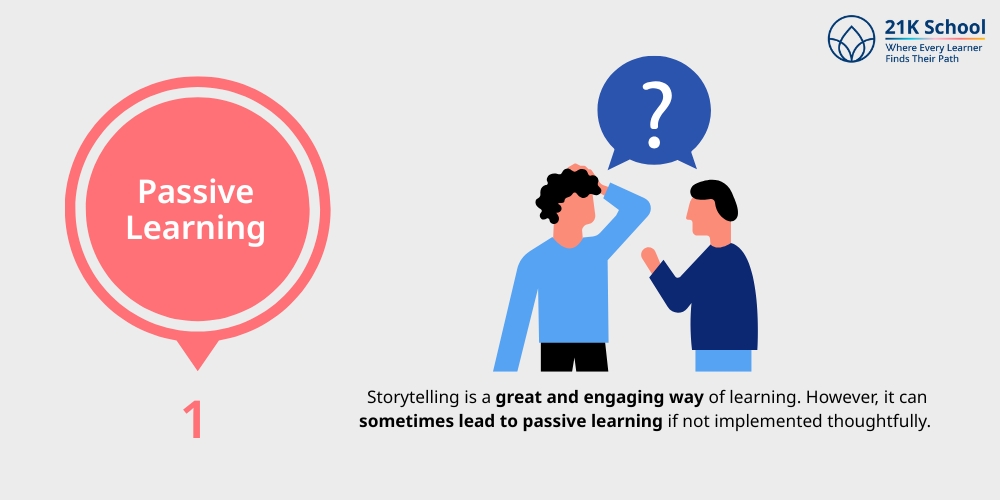
Storytelling is a great and engaging way of learning. However, it can sometimes lead to passive learning if not implemented thoughtfully.
To resolve this, facilitators can transform passive learning into active learning.
This can be done by including interactive elements such as questions, discussions, and activities that encourage students to engage with the story on multiple levels.
2. Cultural Sensitivity
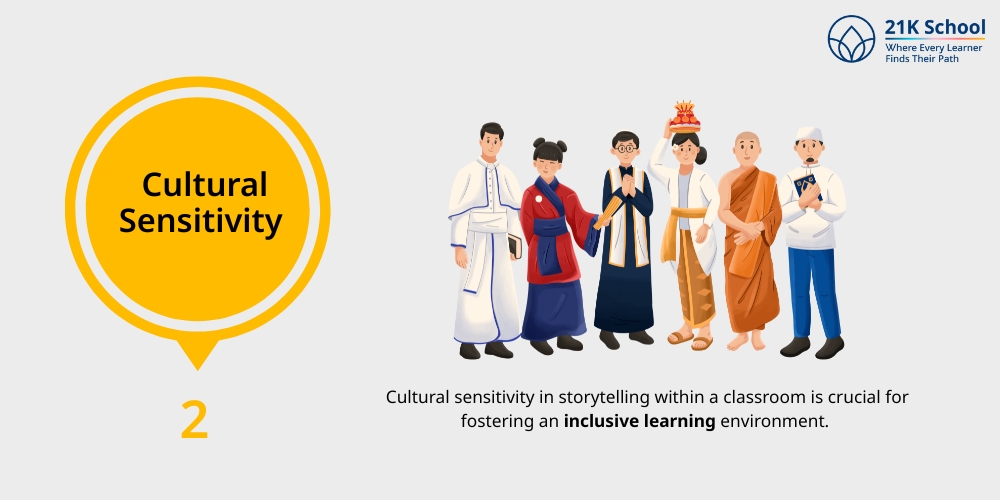
Cultural sensitivity in storytelling within a classroom is crucial for fostering an inclusive learning environment.
It comes with challenges such as potential misinterpretations of stories, perpetuating stereotypes, and inadvertently causing offense.
But, by careful story selection, providing context, encouraging open dialogue and promoting active listening the challenge can be resolved.
3. Retention and Application
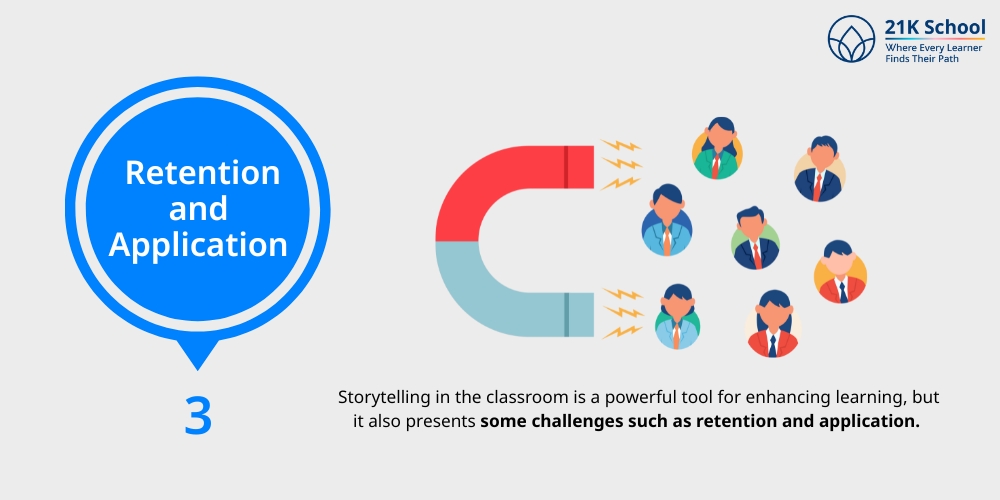
Storytelling in the classroom is a powerful tool for enhancing learning, but it also presents some challenges such as retention and application.
While stories can improve retention, engagement, and critical thinking, facilitators need to address potential issues like cultural sensitivity, creating engaging narratives, and ensuring application of learned material.
Conclusion
In a world full of distractions like mobile, stories give a new way of thinking. It engages both tellers and listeners’ emotions, sparks the imagination and helps to make sense of the world.
Storytelling for learning is an ideal approach that improves learners’ connections, understanding and retaining knowledge. It is applicable everywhere from early childhood education , student leadership programs, to traditional classrooms .
In modern education storytelling enriches the learning experience by adding humanity, emotion and relevance. As facilitators and parents the challenge bangs the doors but dynamic learning ensures solutions.
See the world as full of stories which are waiting to be told. The classroom is a perfect space to begin with.


